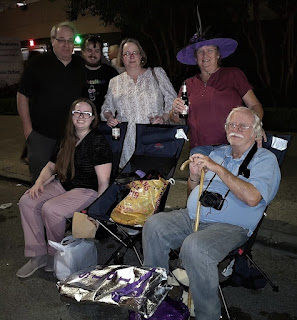Early in the year, Maren asked Deb to plan to fly to New Orleans for the Krewe of Boo parade, an event established only in 2007 as the city's "official" Halloween event. Maren likes it better than the Mardi Gras parades─fewer people, more intimate, and before we knew it, the entire family planned to attend. Thursday morning we took Groome to PDX
and that evening were in N.O. The parade was scheduled for Saturday, several days away; in the meantime, we wandered, enjoying the city as we always have.Deb found an exciting band: Doreen Ketchens, and some unusual friends.I wandered through antiques stores on Royal street and found M.S. Rau, which had some remarkable artifacts: a chess set for only $1,985,000; not old but lovely─each piece an automaton. According to the placard placed with it, the set required 14,000 hours of work over ten years to build.Rau had items similar to some I have, with prices I found hard to believe. It had several kids' rides in pristine condition, including a Bally police motorcycle that in the day cost 10 cents to ride; today it will cost you only $55,000.We stopped at a cigar factory. Deb bought a package for friends.We ate at some outstanding restaurants─at outstanding prices. At Antoine's, the baked Alaska stood out,as did their wine cellar.Established in 1840 and thus the oldest restaurant in New Orleans, Antoine's has fed celebrities such as George Bush, Bill Clinton, Franklin Roosevelt, Pope John Paul II, Brad Pitt, Bruce Willis, Tom Cruise, Kate Hudson, Jimmy buffet, Whoopi Goldberg, Bob Hope, Bing Crosby and now the Johnsons and Bollingers, to name just a few.We spent a good deal of time sitting around catching up; the first time since Covid struck that we have all gotten together.
Saturday evening rolled around and we established spots on the parade route.
Deb had purchased her parade hat.So had Matthew.And the parade rolled on. As they say: Laissez les Bons Temps Rouler; floats, bands,horses,and of course, the horse pooper scooper, with a special Halloween message.Beads were thrown, of course (with no flashing that I saw), as well as souvenir plastic cups, candy, Chee-Wees, pralinettes, light-up medallion beads, voodoo doll pins and magnets, packages of coffee, doubloons, and children's toys. According to the web site, "Krewe of Boo throws are all collectable or consumable, which cuts back on waste." The kids in the crowd picked up the beads and edibles, and I dodged a few items I could not identify that flew at my head until fell into my hands the only item I kept, a 5-inch stuffed pumpkin skeleton, my only souvenir of the weekend, except for the memories.

.jpg)
















































